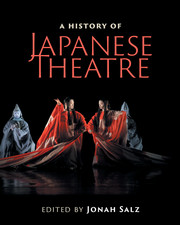Book contents
- Frontmatter
- Contents
- List of figures
- List of tables
- Contributors
- Contributors’ biographies
- Foreword
- Acknowledgments
- Note on Japanese terms
- List of abbreviations
- Timeline
- Editor's introduction
- I Traditional theatres
- Preface to Part I Japanese civilization arises
- II Modern theatres
- Preface to Part II
- III Arcs and patterns
- IV Theatre architecture
- Preface to Part IV Evolution of Japanese theatre architecture
- V Theatre criticism
- VI Intercultural influences
- 22 Seven stages of Shakespeare reception
- 23 Traditional training internationally
- 24 Intercultural theatre: fortuitous encounters
- Interlude Early influence from Europe
- Interlude Asian energy versus European rationality: interview with Ninagawa Yukio
- Epilogue: Frozen words and mythology
- Further reading
- Index
- References
24 - Intercultural theatre: fortuitous encounters
from VI - Intercultural influences
Published online by Cambridge University Press: 05 July 2016
- Frontmatter
- Contents
- List of figures
- List of tables
- Contributors
- Contributors’ biographies
- Foreword
- Acknowledgments
- Note on Japanese terms
- List of abbreviations
- Timeline
- Editor's introduction
- I Traditional theatres
- Preface to Part I Japanese civilization arises
- II Modern theatres
- Preface to Part II
- III Arcs and patterns
- IV Theatre architecture
- Preface to Part IV Evolution of Japanese theatre architecture
- V Theatre criticism
- VI Intercultural influences
- 22 Seven stages of Shakespeare reception
- 23 Traditional training internationally
- 24 Intercultural theatre: fortuitous encounters
- Interlude Early influence from Europe
- Interlude Asian energy versus European rationality: interview with Ninagawa Yukio
- Epilogue: Frozen words and mythology
- Further reading
- Index
- References
Summary
Japan's somewhat reluctant “opening” to the West during the Meiji Restoration (1868–1912) coincided with Western fascination for Japan generated through international expositions, touring troupes, and travelers’ diaries. These helped to establish Japanese dance and theatre in the Western imagination as “original,” “authentic,” “ancient,” and “exotic.” Western artists also discovered that they could effectively incorporate these aspects into their own works, whether through emulation of physical techniques, appropriation of staging techniques, adaptation of stories and structures, or inspired meldings. This chapter examines the influence of Japanese theatre overseas in milestone intercultural performances.
Intercultural performance: fruitful misunderstandings
Postcolonialism and global artistic cross-pollination through international performance festivals and online forums have made appropriations between Western and non-Western cultures increasingly the norm of vanguard experiments. However, the problematic term “intercultural theatre” has recently become more ubiquitous and mutually influential than previously described. Adaptation of plots, techniques, and structures, and the variable Western interpretations of Japanese traditional theatre's “essence,” have all depended on willing and able partners in Japan. Often these advisers and collaborators are in turn changed by their encounter with Western artists and their methods, resulting in similar attempts to change the substance or structures of their own arts, solving problems from a continuously fertile state of “in-betweenness.”
The path to significant intercultural performance is not necessarily straight or predictable, as evidenced by the confusion of language used to describe it. Cross-cultural theatrical interactions have been described variously as hybrids and creoles, melting pots and stews, fissions and fusions, an hour-glass of sifting between Source and Target cultures, and a crossroads. In the early decades of the twentieth century, Japanese theatre practitioners assimilated Western naturalism and problem plays into their nascent modern theatre, but neither consistently nor thoroughly. Brecht's influence came much later than initial contact, while Beckett's was almost immediate; kabuki male onnagata (female role specialists) played alongside actresses in new plays for many decades. Luck of timing and receptive circumstance, and the accidental careers of a few pioneering artists, created modern theatre's variegated textures.
Simultaneously, Western scholars’ and artists’ interest in postimpressionism and art for art's sake, symbolism, futurism, montage, and transcendental philosophies discovered in Asia in general, and in Japan in particular, a living museum of endless inspiration.
- Type
- Chapter
- Information
- A History of Japanese Theatre , pp. 513 - 528Publisher: Cambridge University PressPrint publication year: 2016
References
- 1
- Cited by

